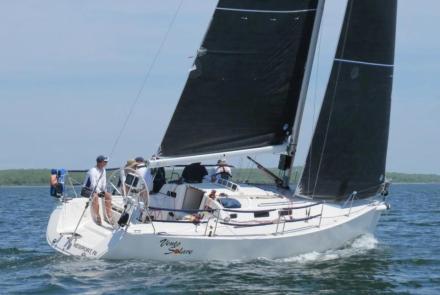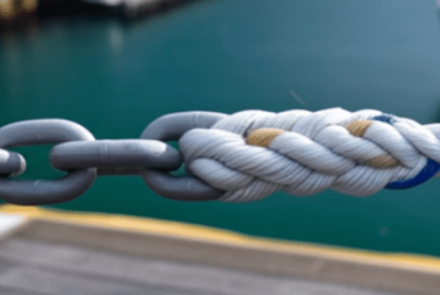Unstable Approaches: Listen to the clues that tell you to reset
CCA Safety Moment for July 2020
Chuck Hawley, San Francisco Station
In late May, Pakistani Airlines flight 8303 crashed while its pilots attempted a second landing at Karachi Airport in Pakistan. The details of this crash can be found on a YouTube channel, “blancolirio”, run by a pilot named Juan Browne. Please watch the four videos that Juan has posted if you want to understand this crash; he does a very good job, and you can see how our knowledge of the cause of the crash improved with the passage of time.
Briefly, the crash was caused by an “unstable approach”. The use of this term may be confusing to mariners, who might think that it refers to vessel stability or resistance to capsize. In commercial aircraft, a “stabilized approach” is defined as being at the right altitude (1000’ above ground), with checklists completed, properly configured, and flying at the target speed + 20 knots/-0 knots. In other words, you’re prepared to land. If any of those requirements are not met, you are said to be flying an “unstable approach” and must go around for another try. This, of course, is an admission that someone in the cockpit likely made an error, or got distracted, or the aircraft is sounding/showing an alarm, and it’s hard to explain to the FAA or the passengers in the cabin why you’re going around.
Sailors can learn from the crash of flight 8303. We can, on occasion, get into a situation that gets more and more difficult from which to recover. This can be caused by ego, or by a sudden change in the expected circumstances, or a lack of “forehandedness”, which was one of the late Capt. John Bonds’s favorite words to throw out at Safety At Sea students. Forehandedness, he’d lecture, was the ability to anticipate possible changes in the current situation and to be ready for them, much as our parents would admonish us to “drive defensively” when we were learning to drive.
As sailors, our environments are constantly changing. Not only the natural environment (wind strength and direction, current, visibility, wave height) but also the physical and manmade environment (vessel traffic, vessel readiness, crew skills). We’ve all witnessed (and perhaps participated in) situations where there were warning signs that we should “go around” or change our tactics, but we instead become hell-bent on continuing. A cursory examination of the grounding of the Torrey Canyon in 1967 shows that the captain refused to consider information from his crew and his own eyes that would have prevented one of the greatest environmental disasters in history. But it’s not just those piloting airliners and ultra large crude carriers who fall prey to a lack of forehandedness.
To illustrate, I was on a crew of a Sydney 38 that has just participated in a buoy race in Santa Cruz. The wind was warm, and a little gusty, and we elected to sail into the narrow entrance of Santa Cruz Harbor with our large spinnaker drawing, knowing that we’d risk a ticket if we were to go past the gas dock with it hoisted. Anticipating the lull caused by the land to the west, the skipper (and crew) felt confident that, despite the several dozen other vessels attempting to navigate the channel, that we’d have enough room.
As luck would have it, a puff chased the Sydney into the harbor and caused it to accelerate towards the increasingly restricted channel. Our speed was probably no more than six knots, but we advanced towards the boats in front of us with too much boatspeed and too little maneuvering room. The skipper could have, at that point, asked to have the spinnaker afterguy “spiked”, or he could have rounded the boat up and risked putting the spinnaker against the mast and rigging. Instead, his focus was on finding an elusive “hole” in the phalanx of small craft that currently prevented his safe passage. With the gas dock to leeward, and the summer sandbar to weather, we had perhaps 200 feet in which to maneuver.
Luck, in this case, was on our side. The gust passed us by, the spinnaker was taken down without a struggle, and a Sydney 38-sized hole opened up in the mass of boats in front of us. We got some pretty shocked stares from the crews of the Moore 24s and FJs and Santana 22s that we cruised past, but no gelcoat was exchanged and no strong words were uttered. My sense is that a number of the crews felt that we were boorish and should have waited our turn, but I can’t be sure. What I am sure of is that we had numerous opportunities to act sooner, but we carried on, hoping for a window to open.
The Captain and the First Officer of flight 8303 had numerous indications that they should have gone around: they were too high, they were too fast, their landing gear would not deploy due to their airspeed, they ignored the audible alarms and landed with the gear up, they decided to go around after grinding their fan jet engines into the runway three separate times, and they ran out of options when the engines failed over a crowded neighborhood. All they had to do was to execute a missed approach and go around, but they decided to land in an “unstable” condition. Close to 100 people died as a result.
The next time you’re feeling that things are developing too quickly, or you don’t understand another vessel’s intentions, or you aren’t sure what are navigation lights and what are traffic lights, or you hear a different sound from the engine, slow down and seek a safe alternative route. Buy yourself some time. Get more crew on deck. Heave-to. Turn offshore. Seek protected waters. Broadcast a Securite call. But don’t carry on because you can’t admit that you’re confused. You may be looking over a rock jetty to the lights of the city and not realize it, or fail to see that you’re cutting between a tug and her barge. Give yourself the gift of time, and take time to get it right.




